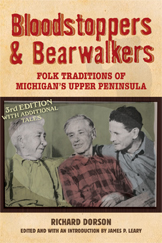Bloodstoppers and Bearwalkers
Folk Traditions of Michigan’s Upper Peninsula
Third Edition, with additional tales
Richard M. Dorson
Edited and with an introduction by James P. Leary
“An important re-introduction of an American folklore classic.”—Carl Lindahl, University of Houston
Remote and rugged, Michigan’s Upper Peninsula (fondly known as “the U.P.”) has been home to a rich variety of indigenous peoples and Old World immigrants—a heritage deeply embedded in today’s “Yooper” culture. Ojibwes, French Canadians, Finns, Cornish, Poles, Italians, Slovenians, and others have all lived here, attracted to the area by its timber, mineral ore, and fishing grounds. Mixing local happenings with supernatural tales and creatively adapting traditional stories to suit changing audiences, the diverse inhabitants of the U.P. have created a wealth of lore populated with tricksters, outlaws, cunning trappers and poachers, eccentric bosses of the mines and lumber camps, “bloodstoppers” gifted with the lifesaving power to stop the flow of blood, “bearwalkers” able to assume the shape of bears, and more.
For folklorist Richard M. Dorson, who ventured into the region in the late 1940s, the U.P. was a living laboratory, a storyteller’s paradise. Bloodstoppers and Bearwalkers, based on his extensive fieldwork in the area, is his richest and most enduring work. This new edition, with a critical introduction and an appendix of additional tales selected by James P. Leary, restores and expands Dorson’s classic contribution to American folklore. Engaging and well informed, the book presents and ponders the folk narratives of the region’s loggers, miners, lake sailors, trappers, and townsfolk. Unfolding the variously peculiar and raucous tales of the U.P., Bloodstoppers and Bearwalkers reveals a vital component of Upper Midwest culture and a fascinating cross-section of American society.
“A collection of traditions, tales, superstitions, practices, and folk biographies that range from the slyly humorous to the bawdy. . . . These are human beings, a folk,
not sitting for a portrait, but caught alive as it were in fine amber, a permanent possession.” —Thelma G. James, Journal of American Folklore
Richard M. Dorson (1916–81) was a professor of history and folklore at Indiana University and the author of many books on American folk traditions, including American Folklore; America in Legend: Folklore from the Colonial Period to the Present; and Folklore and Folklife: An Introduction. James P. Leary is professor of folklore and Scandinavian studies at the University of Wisconsin–Madison, where he also directs the Folklore Program and is cofounder of the Center for the Study of Upper Midwestern Cultures. A native of northern Wisconsin, he is the author of Wisconsin Folklore; So Ole Says to Lena: Folk Humor of the Upper Midwest; and Polkabilly: How the Goose Island Ramblers Redefined American Folk Music.
Media & bookseller inquiries regarding review copies, events, and interviews can be directed to the publicity department at publicity@wwwtest.uwpress.wisc.edu or (608) 263-0734. (If you want to examine a book for possible course use, please see our Course Books page. If you want to examine a book for possible rights licensing, please see Rights & Permissions.)
|
|

June 2008
LC: 2007040522 GR
392 pp. 5 1/2 x 8 1/4
11 b/w illus.
Of Related Interest
So Ole Says to Lena
Folk Humor of the Upper Midwest, Second Edition
Compiled and edited by James P. Leary
|
